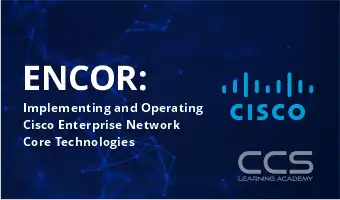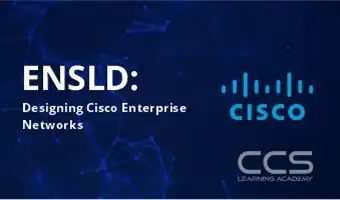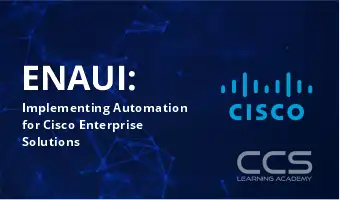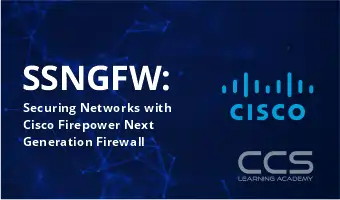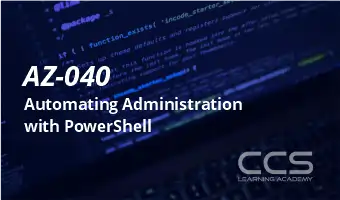Filter by Topic
Filter by Vendor
ENCOR: Implementing and Operating Cisco Enterprise Network Core Technologies
Course Description: The Implementing and Operating Cisco Enterprise Network Core …
What you'll learn
Illustrate the hierarchical network design model and architecture using the access, distribution, and core layers
Compare and contrast the various hardware and software switching mechanisms and operation, while defining the Ternary Content
Addressable Memory (TCAM) and Content Addressable Memory (CAM), along with process switching, fast switching, and Cisco Express Forwarding concepts
Troubleshoot Layer 2 connectivity using VLANs and trunking
Implementation of redundant switched networks using Spanning Tree Protocol
Troubleshooting link aggregation using Etherchannel
Describe the features, metrics, and path selection concepts of Enhanced Interior Gateway Routing Protocol (EIGRP)
Implementation and optimization of Open Shortest Path First (OSPF)v2 and OSPFv3, including adjacencies, packet types, and areas, summarization, and route filtering for IPv4 and IPv6
Implementing External Border Gateway Protocol (EBGP) interdomain routing, path selection, and single and dual-homed networking
Implementing network redundancy using protocols including Hot Standby Routing Protocol (HSRP) and Virtual Router Redundancy Protocol (VRRP)
Implementing internet connectivity within Enterprise using static and dynamic Network Address Translation (NAT)
Describe the virtualization technology of servers, switches, and the various network devices and components
Implementing overlay technologies such as Virtual Routing and Forwarding (VRF), Generic Routing Encapsulation (GRE), VPN, and Location Identifier Separation Protocol (LISP)
Describe the components and concepts of wireless networking including Radio Frequency (RF) and antenna characteristics, and define the specific wireless standards
Describe the various wireless deployment models available, include autonomous Access Point (AP) deployments and cloud-based designs within the centralized Cisco Wireless LAN Controller (WLC) architecture
Describe wireless roaming and location services
Describe how APs communicate with WLCs to obtain software, configurations, and centralized management
Configure and verify Extensible Authentication Protocol (EAP), WebAuth, and Pre-shared Key (PSK) wireless client authentication on a WLC
Troubleshoot wireless client connectivity issues using various available tools
Troubleshooting Enterprise networks using services such as Network Time Protocol (NTP), Simple Network Management Protocol (SNMP), Cisco Internetwork Operating System (Cisco IOS®) IP Service Level Agreements (SLAs), NetFlow, and Cisco IOS Embedded Event Manager
Explain the use of available network analysis and troubleshooting tools, which include show and debug commands, as well as best practices in troubleshooting
Configure secure administrative access for Cisco IOS devices using the Command-Line Interface (CLI) access, Role-Based Access Control (RBAC), Access Control List (ACL), and Secure Shell (SSH), and explore device hardening concepts to secure devices from less secure applications, such as Telnet and HTTP
Implement scalable administration using Authentication, Authorization, and Accounting (AAA) and the local database, while exploring the features and benefits
Describe the enterprise network security architecture, including the purpose and function of VPNs, content security, logging, endpoint security, personal firewalls, and other security features
Explain the purpose, function, features, and workflow of Cisco DNA Center™ Assurance for Intent-Based Networking, for network visibility, proactive monitoring, and application experience
Describe the components and features of the Cisco SD-Access solution, including the nodes, fabric control plane, and data plane, while illustrating the purpose and function of the Virtual Extensible LAN (VXLAN) gateways
Define the components and features of Cisco SD-WAN solutions, including the orchestration plane, management plane, control plane, and data plane
Describe the concepts, purpose, and features of multicast protocols, including Internet Group Management Protocol (IGMP) v2/v3, Protocol-Independent Multicast (PIM) dense mode/sparse mode, and rendezvous points
Describe the concepts and features of Quality of Service (QoS), and describe the need within the enterprise network
Explain basic Python components and conditionals with script writing and analysis
Describe network programmability protocols such as Network Configuration Protocol (NETCONF) and RESTCONF
Describe APIs in Cisco DNA Center and vManage
ENSLD: Designing Cisco Enterprise Networks
In this 5-day course, Designing Cisco Enterprise Networks (ENSLD), students will …
What you'll learn
Design EIGRP internal routing for the enterprise network
Design OSPF internal routing for the enterprise network
Design IS-IS internal routing for the enterprise network
Design a network based on customer requirements
Design BGP routing for the enterprise network
Describe the different types and uses of MP-BGP address families
Describe BGP load sharing
Design a BGP network based on customer requirements
Decide where L2/L3 boundary will be in your Campus network and make design decisions
Describe layer 2 design considerations for Enterprise Campus networks
Design a LAN network based on customer requirements
Describe layer 3 design considerations in an Enterprise Campus network
Examine Cisco SD-Access fundamental concepts
Describe Cisco SD-Access Fabric Design
Design an SD-Access Campus Fabric based on customer requirements
Design service provider-managed VPNs
Design enterprise-managed VPNs
Design a resilient WAN
Design a resilient WAN network based on customer requirements
Examine the Cisco SD-WAN architecture
Describe Cisco SD-WAN deployment options
Design Cisco SD-WAN redundancy
Explain the basic principles of QoS
Design QoS for the WAN
Design QoS for enterprise network based on customer requirements
Explain the basic principles of multicast
Designing rendezvous point distribution solutions
Describe high-level considerations when doing IP addressing design
Create an IPv6 addressing plan
Plan an IPv6 deployment in an existing enterprise IPv4 network
Describe the challenges that you might encounter when transitioning to IPv6
Design an IPv6 addressing plan based on customer requirements
Describe Network APIs and protocols
Describe YANG, NETCONF and RESTCON
ENAUI: Implementing Automation for Cisco Enterprise Solutions
Implementing Automation for Cisco Enterprise Solutions (ENAUI) is a 3-day …
What you'll learn
Describe the various models and APIs of the Cisco IOS-XE platform to perform Day 0 operations, improve troubleshooting methodologies with custom tools, augment the Command-Line Interface (CLI) using scripts, and integrate various workflows using Ansible and Python
Explain the paradigm shift of model-driven telemetry and the building blocks of a working solution
Control the tools and APIs to automate Cisco DNA infrastructure managed by Cisco DNA Center™
Demonstrate workflows (configuration, verification, health checking, and monitoring) using Python, Ansible, and Postman
Explain Cisco SD-WAN solution components, implement a Python library that works with the Cisco SD-WAN APIs to perform configuration, inventory management, and monitoring tasks, and implement reusable Ansible roles to automate provisioning new branch sites on an existing Cisco SD-WAN infrastructure
Manage the tools and APIs to automate Cisco Meraki managed infrastructure and demonstrate workflows (configuration, verification, health checking, monitoring) using Python, Ansible, and Postman
SSNGFW: Securing Networks with Cisco Firepower Next Generation Firewall
Course Description: This lab-intensive 5-day course introduces the student to …
What you'll learn
Describe the Cisco Firepower Threat Defense system and key concepts of NGIPS and NGFW technology
Describe how to perform the configurations tasks required for implementing a Cisco Firepower Threat Defense device
Describe how to implement quality of service (QoS) and Network Address Translation (NAT) by using Cisco Firepower Threat Defense
Perform an initial network discovery using Cisco Firepower to identify hosts, applications, and services
Identify and create the objects required as prerequisites to implementing access control policies
Describe the behavior, usage, and implementation procedure for access control policies
Describe the concepts and implementation procedure of security intelligence features
Describe Cisco Advanced Malware Protection (AMP) for Networks and the implementation procedure of file control and advanced malware protection
Implement and manage intrusion policies
Explain the use of network analysis policies and the role of preprocessor technology in processing network traffic for NGIPS inspection
Describe and demonstrate the detailed analysis techniques and reporting features provided by the Cisco Firepower Management Center
Describe key Cisco Firepower Management Center system administration and user account management features
Describe the processes that can be used to troubleshoot Cisco Firepower Threat Defense systems
InDesign Fundamentals: An Introduction To InDesign CC
Helping Students To Deliver Unparalleled Creative Freedom With InDesign CC …
Adobe InDesign cc Advanced Training Course
Getting Started The Adobe InDesign CC advanced training course by …
What you'll learn
Quick overview of what’s new in CC
Creating tables
Working with transparency
Color/color management
Printing and exporting
Creating Adobe PDF files with form fields
Creating and exporting an e-book
Creating an iPad publication
Working with long documents
What you'll learn
Demonstrate understanding of risk management principles, as formulated in ISO 31000
Establish, maintain, and continually improve a risk management framework, in accordance with ISO 31000 guidelines
Apply the risk management process, in accordance with ISO 31000 guidelines
AZ-040: Automating Administration with PowerShell
This course provides students with the fundamental knowledge and skills …

